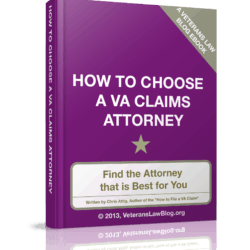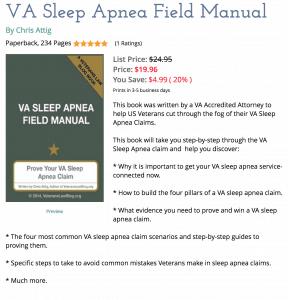What is VA Form 21-2680 used for?
VA Form 21-2680 is a form, filled out by a medical doctor, to support a claim for aid and attendance and/or housebound benefits filed with the Department of Veterans Affairs.
It is not one of the VA claims application forms – instead, it supports a claim for VA aid and attendance (or VA housebound) and has to be prepared and signed by a medical doctor: if you use a nurse practitioner or a physician’s assistant to fill this out, the VA will very likely reject this form. They might demand that you submit a properly prepared form, or they might deny your claim for aid and attendance benefits altogether. (This is something of a double standard, because the VA uses nurse practitioners all the time to establish complex medical proofs)
VA Form 21-2680 is not a claim form – it merely supports a claim.
At a minimum, though, it should be included in any VA disability compensation claim where the veteran is (or is likely to be rated) 100% disabled, is in need of aid and attendance of another person or is housebound. More on those terms later.
If you are filing a claim for a non-service-connected pension, and you or the veteran you are applying for is in need of aid and attendance of another person or is housebound, this form should be included as well.
How do you fill out and complete VA Form 21-2680?
If you go to the VA’s website to download the VA Form 21-2680 (see the link, below), you will see that there are NO instructions on how to fill out this form. This is not that unusual for VA forms, to be honest.
All that the examiner – who fills out the form – gets in terms of guidance is this statement:
“The purpose of this examination is to record manifestations and findings pertinent to the question of whether the claimant is housebound (confined to the home or immediate premises) or in need of the regular aid and attendance of another person. The report should be in sufficient detail for the VA decision makers to determine the extent that disease or injury produces physical or mental impairment, that loss of coordination or enfeeblement affects the ability: to dress and undress; to feed him/herself; to attend to the wants of nature; or keep him/herself ordinarily clean and presentable. Findings should be recorded to show whether the claimant is blind or bedridden. Whether the claimant seeks housebound or aid and attendance benefits, the report should reflect how well he/she ambulates, where he/she goes, and what he/she is able to do during a typical day.”
Not the most helpful, is it?
Truth be told, MOST of the form is pretty self-explanatory.
As with any statement provided in answer to the questions in VA From 21-2680, the best descriptions of medical symptomatology include these 3 factors: frequency, chronicity, and severity. This is because the BVA or the CAVC are more likely to agree that a particular doctor’s statement is more reasoned, and therefore entitled to more evidentiary weight, when a doctor really walks through his or her thinking or reasoning.
This is incredibly useful in answering question like #10, 23, and 28 – 32, which all cut to the core of the need for VA aid and attendance benefits. If your doctor can really tie the answers to those questions together by explaining how the frequency, chronicity and severity of the veteran’s symptoms render him or her housebound or needing aid and attendance, your application is much more likely to sail through the VA.
Again, don’t be afraid to use a continuation sheet. Just because the VA only leaves you room for 3 word answers doesn’t mean that you are limited to 3 word answers on VA Form 21-2680.
Frequency: describe how often a particular symptom affects the veteran’s ability to leave the house.
Chronicity: describe the duration of the particular symptom, not just in the past, but into the future. For example, instead of saying “the veteran cannot drive to his medical appointments” you might say “For the past 18 months, the veteran’s seizures have required that he surrender his driver’s license, and requires him to rely on others to either drive him to his weekly doctor’s appointments, since he lives over a mile from the nearest public bus stop.”
Severity: describe how severe the symptom is. In the context of a claim that a veteran’s symptoms render him or her housebound, saying that “Mr. Smith experiences paranoia due to his PTSD is nowhere near as powerful as saying that “Mr. Smith’s PTSD causes him to feel that every person who comes within 3 feet of him is a physical threat that needs to be neutralized.”
Here are a couple questions that can sometimes be a “trap” for the unwary veteran:
Question #33: “Describe how often per day or week and under what circumstances the claimant is able to leave the home or immediate premises.”
This question is used to support the claim for a housebound veteran.
Please note that there is a difference between being “housebound” and “bedridden.” If a veteran is on doctor’s orders to stay in bed, but is otherwise able to leave the house on his/her own, the veteran probably will not qualify as housebound.
Question #25: “Does the Claimant require nursing home care?”
This can sometimes be a “gotcha” question.
The implication is that a veteran is not in need of aid and attendance if the doctor answers “no.” For this reason, if the answer to this question is “no,” the doctor should note (as appropriate) that the veteran requires custodial care or in-home assistance with his activities of daily living. Don’t be afraid to attach a continuation sheet to more thoroughly explain.
One caveat: a lot of doctors will state that a veteran must stay at a particular facility for its protected environment or requires assistance with protecting the veteran’s home environment. By itself, protecting the veteran’s environment may not be enough to entitle a veteran to aid and attendance as special monthly compensation, so be sure to CLEARLY connect the need for a protected environment to a particular inability to perform 2 or more activities of daily living.
Does VA Form 21-2680 require any supporting documentation?
VA Form 21-2680 can be used as a stand-alone document, meaning it does not REQUIRE additional supporting medical and lay evidence.
However, used strategically, medical and lay evidence can really muscle up your doctor’s answers on VA Form 21-2680. A word of warning, though, using medical and lay evidence improperly can actually make a claim for VA aid and attendance harder than it has to be.
When submitting medical evidence in support of VA Form 21-2680, be sure to include only those records that really illuminate the need for aid-and-attendance or demonstrate the veteran is housebound. The medical evidence should support, bolster or explain what the doctor is saying – it should not be used instead of a doctor’s statement.
Try this: pretend you are a VA rater, and look at the VA Form 21-2680, then look at the medical evidence in support. Does the document confirm, clarify, or explain what the doctor says, or does it require the reader to make a logical assumption, inference, or have some specialized medical knowledge? Remember, the VA raters examining your claim rarely have any medical training, and what they do have is often muddled with years of bad knowledge passed through the VA.
Supporting lay evidence can be helpful, but make sure that it is done on an affidavit or declaration, and forget about the VA Form 21-4138. Again, make sure that the lay evidence really hits on the critical issues of the need for aid and attendance: the veteran’s inability to perform 2 or more activities of daily living without the assistance of another person.
Use the lay evidence worksheet, linked below, to help guide your caretaker or assistant’s written statement.
What are Aid and Attendance Benefits?
There are several types of VA aid and attendance benefits and VA housebound benefits, depending on the nature of the claim and the claimant.
The meaning and proof of VA aid and attendance, and the meaning and proof of VA housebound, are the same for both claims, although the amounts of compensation are different.
Pension – If you are seeking a non-service-connected pension, there are three levels of compensation available to you. The first is the base level of compensation, which is computed based on a veteran’s income needs (a formula too complicated for this post), and is paid when a veteran is disabled due to a non-service connected disability. The second is the base plus housebound, and the third is base plus aid-and-attendance.
A word of warning – there is an entire cottage-industry built around pushing veterans and their surviving spouses into assisted-living facilities through the use of aid-and-attendance enhancements to the non-service-connected pension.
These folks are called “pension poachers.”
These pension-poachers prey on the veteran or survivor who does not know better, and force them to put all of their earthly assets into an irrevocable trust, spend down their income, pay the person/company helping with the application several thousand dollars, and leave the elderly survivor or veteran with little to show for it other than an irrevocable trust with someone else controlling all of their assets. These pension poachers rarely assist veterans or survivors with disability compensation benefits, which can often be a better financial resource for the veteran or claimant. Thankfully, the VA has started to crack down on pension poaching, but these companies are a dime a dozen, and I hear every week of the lives they destroy.
Now, don’t get me wrong, the aid-and-attendance enhancement to the non-service-connected pension is a valuable financial resource for a great many veterans. But, in most cases, you do not have to pay several thousand dollars up front to someone who is often an insurance agent saying they work under the supervision of an attorney, usually out of state.
VA Disability Compensation – If you are 100% service-connected, and are either housebound or in need of assistance of another due to your service connected disabilities, you are likely entitled to an additional amount of special monthly compensation known as SMC-L.
SMC-L is the first – and basic – level of special monthly compensation. It is available to veterans for many reasons – loss or loss of use of certain extremities, certain levels of blindness, permanently bedridden, in need of VA aid and attendance, etc. Where a veteran is permanently bedridden, they almost always meet the criteria for VA aid and attendance, so the key here is “permanently” bedridden, and not just temporarily bedridden on doctor’s orders.
You can only get one payment of SMC-L, even if you have multiple qualifying bases for it. Depending on the current years’ VA special monthly compensation rate tables, SMC-L can add almost $800 a month to a 100% disabled veteran’s compensation.
Am I eligible for VA aid and attendance benefits?
The eligibility criteria for VA aid and attendance are actually some of the more straightforward in the entire world of VA disability benefits.
To qualify for VA aid and attendance, in any type of compensation claim, you need only prove that you are in regular need of the assistance of another person with two or more “Activities of Daily Living” (also known as “ADLs”).
The key terms are “regular” and “ADL”.
Thus, there are only two real questions:
1) What is “regular need” of assistance?
This is where the fight for VA aid and attendance often occurs: the VA and the claimant do not see “eye-to-eye” on what “regular need of assistance” means.
Too often, the VA wants it to mean “constant,” but it has been made clear time and again that this is too high a standard.
A good rule of thumb is that you are in “regular need of assistance” if you need the help of another person at least 2-3 times per week, or if you need custodial care. But, this will often come down to how well your doctor describes your need – in terms of frequency, chronicity and severity – on VA Form 21-2680.
2) What is and is not an ADL (for VA purposes)?
This is another friction point between veterans and the VA. Veterans want any activity that is important to them to be an “activity of daily living” or ADL.
However, the list of ADL’s for VA aid and attendance purposes is short: bathing, dressing, transferring, eating, toileting, and personal hygiene.
The list of what is NOT an ADL for VA aid and attendance purposes is long, and while there are exceptions to the list above, they are rare. The most common things that I have seen veterans try to claim that are not ADLs for VA aid and attendance are food or meal preparation, assistance taking or knowing when to take medicine, and assistance protecting the veteran from hazards in his or her environment.
This last one can be confusing – often underlying the need for safety in the veteran’s environment is the need for regular assistance in performing an ADL. For that reason, think about WHY the veteran needs help protecting his or her environment: is it because they might slip in the shower because they cannot bathe themselves? Is it because their TBI interferes with their ability to swallow, thus requiring a regular need for assistance eating?
What are the income limits for VA aid and attendance?
If you are seeking VA aid and attendance as a special monthly compensation enhancement to a 100% disability rating, there are no income limits. Almost every VA service-connected disability compensation benefits is paid to a veteran regardless of his or her income levels.
If you are seeking VA aid and attendance as an enhancement to an non-service connected pension, then you need to meet the income requirements of the NSC pension itself. This is a confusing formula, and I’m not going to explain it here.
Frankly, I’m afraid this post is already too long.
Links.
Click here to download the VA Form 21-2680 PDF form from the VA website.
Click here to download my Lay Evidence Worksheet for in-home caregivers in VA aid and attendance claims.





